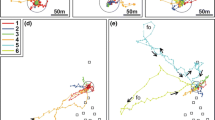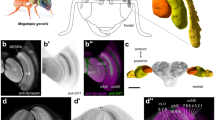Abstract
Honeybees flying repeatedly over the same trajectory link it to an associated visual stimulus such that on viewing the stimulus they perform a trajectory in the habitual direction. To test if trajectory length can also be linked to a visual stimulus, bees were trained to fly through a multi-comparmented maze. Bees flew through a multi-compartmented maze. In one compartment a short trajectory could be linked to a stripe pattern oriented at 45° to the horizontal. In another compartment a longer trajectory could be linked to 135° stripes. Bees made both associations: their trajectories were short when viewing 45° stripes and longer when viewing 135° stripes. 90° stripes evoked trajectories of intermediate length.
To test if distance and direction are linked independently to stripe orientation, a bee's trajectory was linked to 135° stripes in one compartment and to 45° stripes in another. These trajectories were the same length but differed in their horizontal direction by 60° or by 120°. 90° stripes evoked trajectories of intermediate direction which were shorter than those elicited by either training pattern. Bees were also trained to generate one long and one short trajectory with directions 120° apart. The trajectories elicited by 90° stripes were then biased towards the direction of the long training vector. Length and direction are not treated separately. The rules for combining trajectories resemble those of vector averaging.
Similar content being viewed by others
References
Batschelet E (1981) Circular statistics in biology. Academic Press, New York
Becker L (1958) Untersuchungen über das Heimfindervermögen der Bienen. Z vergl Physiol 41: 1–25
Collett TS, Baron J (1995) Learnt sensori-motor mappings in honeybees: interpolation and its possible relevance to navigation. J Comp Physiol A 177: 287–298
Collett TS, Fry SN, Wehner R (1993) Sequence learning by honeybees. J Comp Physiol A 172: 693–706
Esch HE, Burns JE (1995) Honeybees use optic flow to measure the distance of a food source. Naturwissenschaften 82: 38–40
Frisch K von (1967) The dance language and orientation of bees. Belknap, Harvard, Cambridge, Mass
Georgopoulos AP (1994) New concepts in generation of movement. Neuron 13: 257–268
Hebb DO (1949) The organization of behavior. Wiley, New York
Menzel R, Joerges J, Müller U (1995) Algorithmic phenomena in long distance orientation of honey bees. In: Elsner N, Menzel R (eds) Learning and memory. Proc 23 Göttingen Neurobiol Conf. Thieme, Stuttgart, pp
Mittelstaedt H, Mittelstaedt, ML (1973) Mechanismen der Orientierung ohne richtende Aussenreize. Fortschr Zool 21: 46–58
Müller M, Wehner R (1988) Path integration in desert ants, Cataglyphis fortis. Proc Natl Acad Sci USA 85: 5287–5290
Romanes G (1885) Homing faculty of Hymenoptera. Nature 32: 630
Srinivasan MV, Zhang SW, Witney K (1994) Visual discrimination of pattern orientation by honey bees: performance and implications for ‘cortical’ processing. Phil Trans R Soc Lond B 343: 199–210
Srinivasan MV, Zhang SW, Lehrer M, Collett TS (1996) Honeybee navigation en route to the goal: visual flight control and odometry. J Exp Biol 199: 237–244
Wehner R (1992) Arthropods. In: Papi F (ed) Animal homing. Chapman & Hall, London, pp 45–144
Wehner R, Bleuler S, Nievergelt C, Shah D (1990) Bees navigate by using vectors and routes rather than maps. Naturwissenschaften 77: 470–482
Author information
Authors and Affiliations
Rights and permissions
About this article
Cite this article
Collett, T.S., Baron, J. & Sellen, K. On the encoding of movement vectors by honeybees. Are distance and direction represented independently?. J Comp Physiol A 179, 395–406 (1996). https://doi.org/10.1007/BF00194993
Accepted:
Issue Date:
DOI: https://doi.org/10.1007/BF00194993




